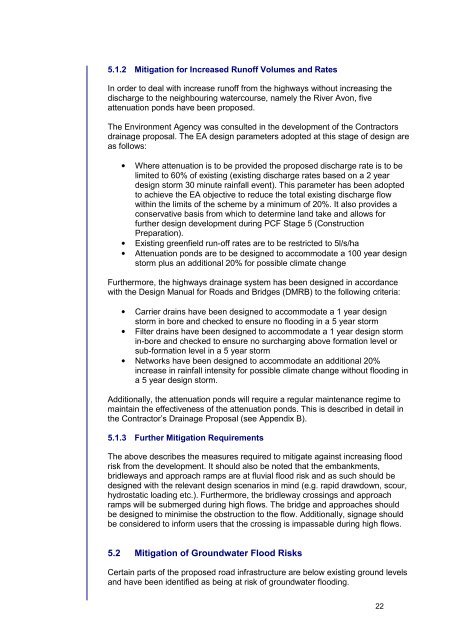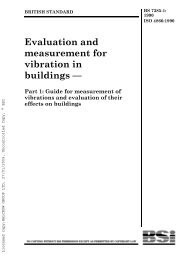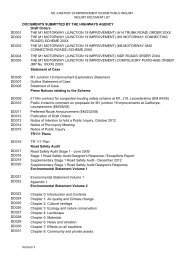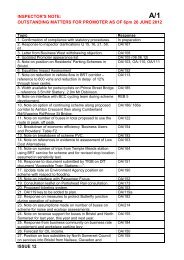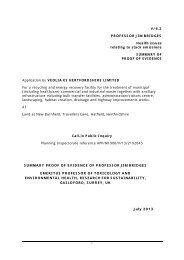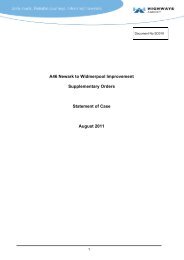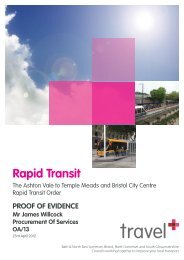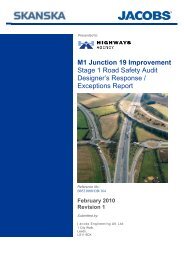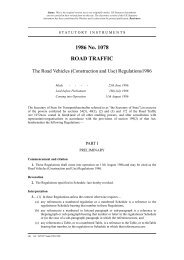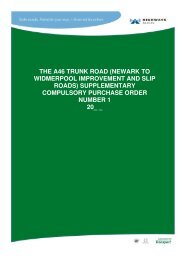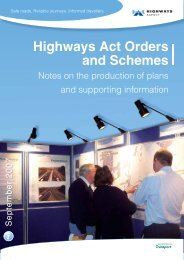Chapter 9: Road drainage and the water environment
Chapter 9: Road drainage and the water environment
Chapter 9: Road drainage and the water environment
You also want an ePaper? Increase the reach of your titles
YUMPU automatically turns print PDFs into web optimized ePapers that Google loves.
5.1.2 Mitigation for Increased Runoff Volumes <strong>and</strong> Rates<br />
In order to deal with increase runoff from <strong>the</strong> highways without increasing <strong>the</strong><br />
discharge to <strong>the</strong> neighbouring <strong>water</strong>course, namely <strong>the</strong> River Avon, five<br />
attenuation ponds have been proposed.<br />
The Environment Agency was consulted in <strong>the</strong> development of <strong>the</strong> Contractors<br />
<strong>drainage</strong> proposal. The EA design parameters adopted at this stage of design are<br />
as follows:<br />
• Where attenuation is to be provided <strong>the</strong> proposed discharge rate is to be<br />
limited to 60% of existing (existing discharge rates based on a 2 year<br />
design storm 30 minute rainfall event). This parameter has been adopted<br />
to achieve <strong>the</strong> EA objective to reduce <strong>the</strong> total existing discharge flow<br />
within <strong>the</strong> limits of <strong>the</strong> scheme by a minimum of 20%. It also provides a<br />
conservative basis from which to determine l<strong>and</strong> take <strong>and</strong> allows for<br />
fur<strong>the</strong>r design development during PCF Stage 5 (Construction<br />
Preparation).<br />
• Existing greenfield run-off rates are to be restricted to 5l/s/ha<br />
• Attenuation ponds are to be designed to accommodate a 100 year design<br />
storm plus an additional 20% for possible climate change<br />
Fur<strong>the</strong>rmore, <strong>the</strong> highways <strong>drainage</strong> system has been designed in accordance<br />
with <strong>the</strong> Design Manual for <strong>Road</strong>s <strong>and</strong> Bridges (DMRB) to <strong>the</strong> following criteria:<br />
• Carrier drains have been designed to accommodate a 1 year design<br />
storm in bore <strong>and</strong> checked to ensure no flooding in a 5 year storm<br />
• Filter drains have been designed to accommodate a 1 year design storm<br />
in-bore <strong>and</strong> checked to ensure no surcharging above formation level or<br />
sub-formation level in a 5 year storm<br />
• Networks have been designed to accommodate an additional 20%<br />
increase in rainfall intensity for possible climate change without flooding in<br />
a 5 year design storm.<br />
Additionally, <strong>the</strong> attenuation ponds will require a regular maintenance regime to<br />
maintain <strong>the</strong> effectiveness of <strong>the</strong> attenuation ponds. This is described in detail in<br />
<strong>the</strong> Contractor’s Drainage Proposal (see Appendix B).<br />
5.1.3 Fur<strong>the</strong>r Mitigation Requirements<br />
The above describes <strong>the</strong> measures required to mitigate against increasing flood<br />
risk from <strong>the</strong> development. It should also be noted that <strong>the</strong> embankments,<br />
bridleways <strong>and</strong> approach ramps are at fluvial flood risk <strong>and</strong> as such should be<br />
designed with <strong>the</strong> relevant design scenarios in mind (e.g. rapid drawdown, scour,<br />
hydrostatic loading etc.). Fur<strong>the</strong>rmore, <strong>the</strong> bridleway crossings <strong>and</strong> approach<br />
ramps will be submerged during high flows. The bridge <strong>and</strong> approaches should<br />
be designed to minimise <strong>the</strong> obstruction to <strong>the</strong> flow. Additionally, signage should<br />
be considered to inform users that <strong>the</strong> crossing is impassable during high flows.<br />
5.2 Mitigation of Ground<strong>water</strong> Flood Risks<br />
Certain parts of <strong>the</strong> proposed road infrastructure are below existing ground levels<br />
<strong>and</strong> have been identified as being at risk of ground<strong>water</strong> flooding.<br />
22


